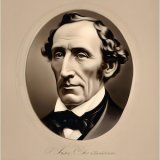Little Ida's Flowers
Little Ida's Flowers is a charming children's story written by Hans Christian Andersen. The book revolves around a young girl named Ida, who wonders why her flowers look tired and wilted. An enchanting tale unfolds when she learns from a student living with her family that flowers can speak, dance and engage in nighttime balls. As Ida falls asleep, she dreams of her flowers engaging in a grand ball. The next day, Ida takes the student's advice on how to revive their strength. This delightful story is filled with whimsy, imagination and beautiful elements of fairy-tale fantasy.
Genre: Children
Genre: Children
- 21 Views
"My poor flowers are quite dead," said little Ida, "they were so pretty yesterday evening, and now all the leaves are hanging down quite withered. What do they do that for," she asked, of the student who sat on the sofa; she liked him very much, he could tell the most amusing stories, and cut out the prettiest pictures; hearts, and ladies dancing, castles with doors that opened, as well as flowers; he was a delightful student. "Why do the flowers look so faded to-day?" she asked again, and pointed to her nosegay, which was quite withered. "Don't you know what is the matter with them?" said the student. "The flowers were at a ball last night, and therefore, it is no wonder they hang their heads." "But flowers cannot dance?" cried little Ida. "Yes indeed, they can," replied the student. "When it grows dark, and everybody is asleep, they jump about quite merrily. They have a ball almost every night." "Can children go to these balls?" "Yes," said the student, "little daisies and lilies of the valley." "Where do the beautiful flowers dance?" asked little Ida. "Have you not often seen the large castle outside the gates of the town, where the king lives in summer, and where the beautiful garden is full of flowers? And have you not fed the swans with bread when they swam towards you? Well, the flowers have capital balls there, believe me." "I was in the garden out there yesterday with my mother," said Ida, "but all the leaves were off the trees, and there was not a single flower left. Where are they? I used to see so many in the summer." "They are in the castle," replied the student. "You must know that as soon as the king and all the court are gone into the town, the flowers run out of the garden into the castle, and you should see how merry they are. The two most beautiful roses seat themselves on the throne, and are called the king and queen, then all the red cockscombs range themselves on each side, and bow, these are the lords-in-waiting. After that the pretty flowers come in, and there is a grand ball. The blue violets represent little naval cadets, and dance with hyacinths and crocuses which they call young ladies. The tulips and tiger-lilies are the old ladies who sit and watch the dancing, so that everything may be conducted with order and propriety." "But," said little Ida, "is there no one there to hurt the flowers for dancing in the king's castle?" "No one knows anything about it," said the student. "The old steward of the castle, who has to watch there at night, sometimes comes in; but he carries a great bunch of keys, and as soon as the flowers hear the keys rattle, they run and hide themselves behind the long curtains, and stand quite still, just peeping their heads out. Then the old steward says, 'I smell flowers here,' but he cannot see them." "Oh how capital," said little Ida, clapping her hands. "Should I be able to see these flowers?" "Yes," said the student, "mind you think of it the next time you go out, no doubt you will see them, if you peep through the window. I did so to-day, and I saw a long yellow lily lying stretched out on the sofa. She was a court lady." "Can the flowers from the Botanical Gardens go to these balls?" asked Ida. "It is such a distance!" "Oh yes," said the student, "whenever they like, for they can fly. Have you not seen those beautiful red, white, and yellow butterflies, that look like flowers? They were flowers once. They have flown off their stalks into the air, and flap their leaves as if they were little wings to make them fly. Then, if they behave well, they obtain permission to fly about during the day, instead of being obliged to sit still on their stems at home, and so in time their leaves become real wings. It may be, however, that the flowers in the Botanical Gardens have never been to the king's palace, and, therefore, they know nothing of the merry doings at night, which take place there. I will tell you what to do, and the botanical professor, who lives close by here, will be so surprised. You know him very well, do you not? Well, next time you go into his garden, you must tell one of the flowers that there is going to be a grand ball at the castle, then that flower will tell all the others, and they will fly away to the castle as soon as possible. And when the professor walks into his garden, there will not be a single flower left. How he will wonder what has become of them!" "But how can one flower tell another? Flowers cannot speak?" "No, certainly not," replied the student; "but they can make signs. Have you not often seen that when the wind blows they nod at one another, and rustle all their green leaves?" "Can the professor understand the signs?" asked Ida. "Yes, to be sure he can. He went one morning into his garden, and saw a stinging nettle making signs with its leaves to a beautiful red carnation. It was saying, 'You are so pretty, I like you very much.' But the professor did not approve of such nonsense, so he clapped his hands on the nettle to stop it. Then the leaves, which are its fingers, stung him so sharply that he has never ventured to touch a nettle since." "Oh how funny!" said Ida, and she laughed. "How can anyone put such notions into a child's head?" said a tiresome lawyer, who had come to pay a visit, and sat on the sofa. He did not like the student, and would grumble when he saw him cutting out droll or amusing pictures. Sometimes it would be a man hanging on a gibbet and holding a heart in his hand as if he had been stealing hearts. Sometimes it was an old witch riding through the air on a broom and carrying her husband on her nose. But the lawyer did not like such jokes, and he would say as he had just said, "How can anyone put such nonsense into a child's head! what absurd fancies there are!" But to little Ida, all these stories which the student told her about the flowers, seemed very droll, and she thought over them a great deal. The flowers did hang their heads, because they had been dancing all night, and were very tired, and most likely they were ill.
Translation
Translate and read this book in other languages:
Select another language:
- - Select -
- 简体中文 (Chinese - Simplified)
- 繁體中文 (Chinese - Traditional)
- Español (Spanish)
- Esperanto (Esperanto)
- 日本語 (Japanese)
- Português (Portuguese)
- Deutsch (German)
- العربية (Arabic)
- Français (French)
- Русский (Russian)
- ಕನ್ನಡ (Kannada)
- 한국어 (Korean)
- עברית (Hebrew)
- Gaeilge (Irish)
- Українська (Ukrainian)
- اردو (Urdu)
- Magyar (Hungarian)
- मानक हिन्दी (Hindi)
- Indonesia (Indonesian)
- Italiano (Italian)
- தமிழ் (Tamil)
- Türkçe (Turkish)
- తెలుగు (Telugu)
- ภาษาไทย (Thai)
- Tiếng Việt (Vietnamese)
- Čeština (Czech)
- Polski (Polish)
- Bahasa Indonesia (Indonesian)
- Românește (Romanian)
- Nederlands (Dutch)
- Ελληνικά (Greek)
- Latinum (Latin)
- Svenska (Swedish)
- Dansk (Danish)
- Suomi (Finnish)
- فارسی (Persian)
- ייִדיש (Yiddish)
- հայերեն (Armenian)
- Norsk (Norwegian)
- English (English)
Citation
Use the citation below to add this book to your bibliography:
Style:MLAChicagoAPA
"Little Ida's Flowers Books." Literature.com. STANDS4 LLC, 2024. Web. 8 May 2024. <https://www.literature.com/book/little_ida%27s_flowers_2187>.




Discuss this Little Ida's Flowers book with the community:
Report Comment
We're doing our best to make sure our content is useful, accurate and safe.
If by any chance you spot an inappropriate comment while navigating through our website please use this form to let us know, and we'll take care of it shortly.
Attachment
You need to be logged in to favorite.
Log In